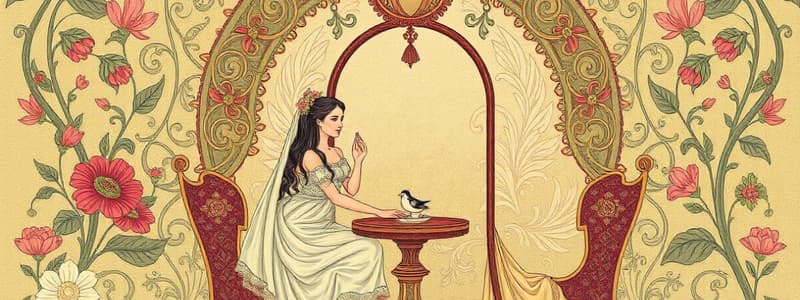Podcast
Questions and Answers
What is the principle that creates an impression of unity through consistent objects or ideas?
What is the principle that creates an impression of unity through consistent objects or ideas?
- Harmony (correct)
- Contrast
- Composition
- Balance
Which aspect of harmony is characterized by the use of repeated elements to create patterns?
Which aspect of harmony is characterized by the use of repeated elements to create patterns?
- Repetition (correct)
- Harmony of size
- Harmony of color
- Harmony of texture
How can lines be made harmonious according to the principles of design?
How can lines be made harmonious according to the principles of design?
- By avoiding curved lines altogether
- By varying the colors of lines
- By using only straight lines
- By connecting transitional lines to contrasting lines (correct)
What does ‘harmony of size’ refer to in design?
What does ‘harmony of size’ refer to in design?
What is a transitional line described as?
What is a transitional line described as?
What characterizes the harmony of color in design?
What characterizes the harmony of color in design?
Which aspect of harmony involves the idea that all themes in a piece of art should work together?
Which aspect of harmony involves the idea that all themes in a piece of art should work together?
How can the character of texture be determined?
How can the character of texture be determined?
Flashcards are hidden until you start studying
Study Notes
Harmony in Visual Arts
- Harmony is the principle that creates a sense of unity by carefully arranging and selecting consistent objects or ideas.
- Harmony acts as a unifying force, bringing all elements of an arrangement together.
- There are five key aspects of harmony in visual arts:
- Harmony of lines and shapes:
- Achieved through repeating similar shapes or connecting contrasting lines with transitional lines.
- Transitional lines are typically curved and graceful, connecting opposing lines.
- Contrasting or opposing lines are straight lines intersecting to form angles.
- Contradiction acts as a form of transition, with a straight line connecting opposing lines diagonally.
- Repetition involves using similar visual elements to create patterns.
- Harmony of size: Refers to creating a pleasing proportion between different elements.
- Harmony of color: Requires using two or more colors when decorating an object.
- Harmony of texture: Can be determined by touch or visual observation.
- Harmony of idea: In art, it means all ideas and themes within a artwork work together cohesively to create a meaningful and complete piece.
- Harmony of lines and shapes:
Studying That Suits You
Use AI to generate personalized quizzes and flashcards to suit your learning preferences.




